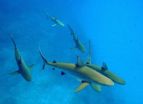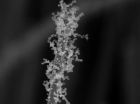(Press-News.org) Aging may seem unavoidable, but that's not necessarily so when it comes to the brain. So say researchers in the April 27th issue of the Cell Press journal Trends in Cognitive Sciences explaining that it is what you do in old age that matters more when it comes to maintaining a youthful brain not what you did earlier in life.
"Although some memory functions do tend to decline as we get older, several elderly show well preserved functioning and this is related to a well-preserved, youth-like brain," says Lars Nyberg of Umeå University in Sweden.
Education won't save your brain -- PhDs are as likely as high-school dropouts to experience memory loss with old age, the researchers say. Don't count on your job either. Those with a complex or demanding career may enjoy a limited advantage, but those benefits quickly dwindle after retirement.
Engagement is the secret to success. Those who are socially, mentally and physically stimulated reliably show better cognitive performance with a brain that appears younger than its years.
"There is quite solid evidence that staying physically and mentally active is a way towards brain maintenance," Nyberg says.
The researchers say this new take on successful aging represents an important shift in focus for the field. Much attention in the past has gone instead to understanding ways in which the brain copes with or compensates for cognitive decline in aging. The research team now argues for the importance of avoiding those age-related brain changes in the first place. Genes play some role, but life choices and other environmental factors, especially in old age, are critical.
Elderly people generally do have more trouble remembering meetings or names, Nyberg says. But those memory losses often happen later than many often think, after the age of 60. Older people also continue to accumulate knowledge and to use what they know effectively, often to very old ages.
"Taken together, a wide range of findings provides converging evidence for marked heterogeneity in brain aging," the scientists write. "Critically, some older adults show little or no brain changes relative to younger adults, along with intact cognitive performance, which supports the notion of brain maintenance. In other words, maintaining a youthful brain, rather than responding to and compensating for changes, may be the key to successful memory aging."
###
Nyberg et al.: "Memory aging and brain maintenance."
END
HONOLULU – April 25, 2012 -- Many shark populations have plummeted in the past three decades as a result of excessive harvesting – for their fins, as an incidental catch of fisheries targeting other species, and in recreational fisheries. This is particularly true for oceanic species. However, until now, a lack of data prevented scientists from properly quantifying the status of Pacific reef sharks at a large geographic scale.
In a study published online April 27 in the journal Conservation Biology, an international team of marine scientists provide the first estimates ...
Scientists at the University of Liverpool have found that mice and rats have evolved to gnaw with their front teeth and chew with their back teeth more successfully than rodents that 'specialise' in one or other of these biting mechanisms.
Researchers designed a computer model to simulate the bite of rats to understand whether their skull shape or muscle arrangement was a major factor in their evolutionary success and global dominance, making them one of the most common pest species in the world.
Research has already shown that rats and mice can both chew and gnaw, ...
(Toronto) - Researchers at the Centre for Addiction and Mental Health (CAMH) led a study discovering a gene for a new form of intellectual disability, as well as how it likely affects cognitive development by disrupting neuron functioning.
CAMH Senior Scientist Dr. John Vincent and his team found a mutation in the gene NSUN2 among three sisters with intellectual disability, a finding to be published in the May issue of the American Journal of Human Genetics.
The discovery was made after mapping genes in a Pakistani family, in which three of seven siblings had intellectual ...
Like a lead actress on the red carpet, nanowires—those superstars of nanotechnology—can be enhanced by a little jewelry, too. Not the diamonds and pearls variety, but the sort formed of sinuous chains of metal oxide or noble metal nanoparticles.
Though science has known for some time that such ornamentation can greatly increase the surface area and alter the surface chemistry of nanowires, engineers at Stanford University have found a novel and more effective method of "decorating" nanowires that is simpler and faster than previous techniques. The results of their study ...
Claudia Bieber from the Research Institute of Wildlife Ecology (FIWI) of the University of Veterinary Medicine, Vienna, and fellow scientists analysed a capture-recapture data set on common dormice (Muscardinus avellanarius) to investigate the life-history strategy of this species. These small rodents are about the size and weight of a wood mouse (Apodemus sylvaticus), but, unlike their rodent cousins, they hibernate – usually from late September/October to April/May. This is reflected in rather different life history strategies: While wood mice may reproduce any time between ...
China's economic growth will continue to be energy-intensive and highly polluting for the foreseeable future with emissions and efficiency far below capital growth on the agenda, according to a study published in the International Journal of Global Energy Issues.
Economist Yanqing Xia of Dongbei University of Finance and Economics and the Northeast Branch of the Chinese Academy of Sciences in Liaoning has looked at almost a decade's worth of data from 30 Chinese provinces to build a comprehensive model of pollution, energy consumption and economic growth. The model offers ...
Our genes control many aspects of who we are — from the colour of our hair to our vulnerability to certain diseases — but how are the genes, and consequently the proteins they make themselves controlled?
Researchers have discovered a new group of molecules which control some of the fundamental processes behind memory function and may hold the key to developing new therapies for treating neurodegenerative diseases.
The research, led by academics from the University of Bristol's Schools of Clinical Sciences, Biochemistry and Physiology and Pharmacology and published ...
BUFFALO, N.Y. -- Obese drivers are far less likely to wear seatbelts than are drivers of normal weight, a new University at Buffalo study has found, a behavior that puts them at greater risk of severe injury or death during motor vehicle crashes.
The UB study found that normal weight drivers are 67 percent more likely to wear a seatbelt than morbidly obese drivers. Drivers were considered overweight or obese if they had a BMI (body mass index) of 25 or more, according to the World Health Organization definition of obesity, with 25-30 defined as overweight, 30-35 slightly ...
In a new study, scientists at the University of Copenhagen show that a specific type of carbohydrate plays an important role in the intercellular signalling that controls the growth and development of the nervous system. In particular, defects in that carbohydrate may result in the uninhibited cell growth that characterizes the genetic disease neurofibromatosis and certain types of cancer. The results have just been published in the well-reputed journal PNAS.
Scientists from The Faculty of Health and Medical Sciences at the University of Copenhagen have put a special ...
This press release is available in German.
In particle physics, the baryon family refers to particles that are made up of three quarks. Quarks form a group of six particles that differ in their masses and charges. The two lightest quarks, the so-called "up" and "down" quarks, form the two atomic components, protons and neutrons. All baryons that are composed of the three lightest quarks ("up", "down" and "strange" quarks) are known. Only very few baryons with heavy quarks have been observed to date. They can only be generated artificially in particle accelerators as ...

